Are you curious about the owls that call Montana home? You’re in for a treat. From the elusive Great Gray Owl to the tiny Northern Pygmy Owl, Montana hosts a variety of fascinating birds. We’ll guide you through their habitats, behaviors, and owl-watching in the state.
You’ll meet the 15 species that grace the state with their presence. Each owl has its own story, from the eerie bird calls of the Barn Owl to the daytime hunts of the Northern Hawk Owl. We’ll share where to find them and what makes them unique.
- Related article: Explore Wildlife in Montana
Are you ready to explore the world of Montana owls? Let’s discover these majestic birds and learn how to observe them respectfully.
7 Key Takeaways on the Species of Owls in Montana
- Montana has 15 various owl species, each with unique characteristics and habitats.
- Owls like the Barn Owl and Barred Owl face challenges due to habitat loss and predators, emphasizing the importance of conservation efforts.
- Despite its small size, the Boreal Owl plays a significant role in Montana’s ecosystem and is a species of interest for wildlife enthusiasts.
- Known for their ground-dwelling habits, Burrowing Owls face population declines linked to environmental changes.
- The Eastern Screech-Owl’s distinctive calls and nesting behaviors highlight the diversity of owl adaptations.
- With their small size and specific calls, Flammulated Owls are a testament to Montana’s unique biodiversity.
- Great Gray Owls are the largest owl species in North America. They are remarkable hunters that can be challenging to spot in Montana’s landscapes.
15 Owl Species in Montana
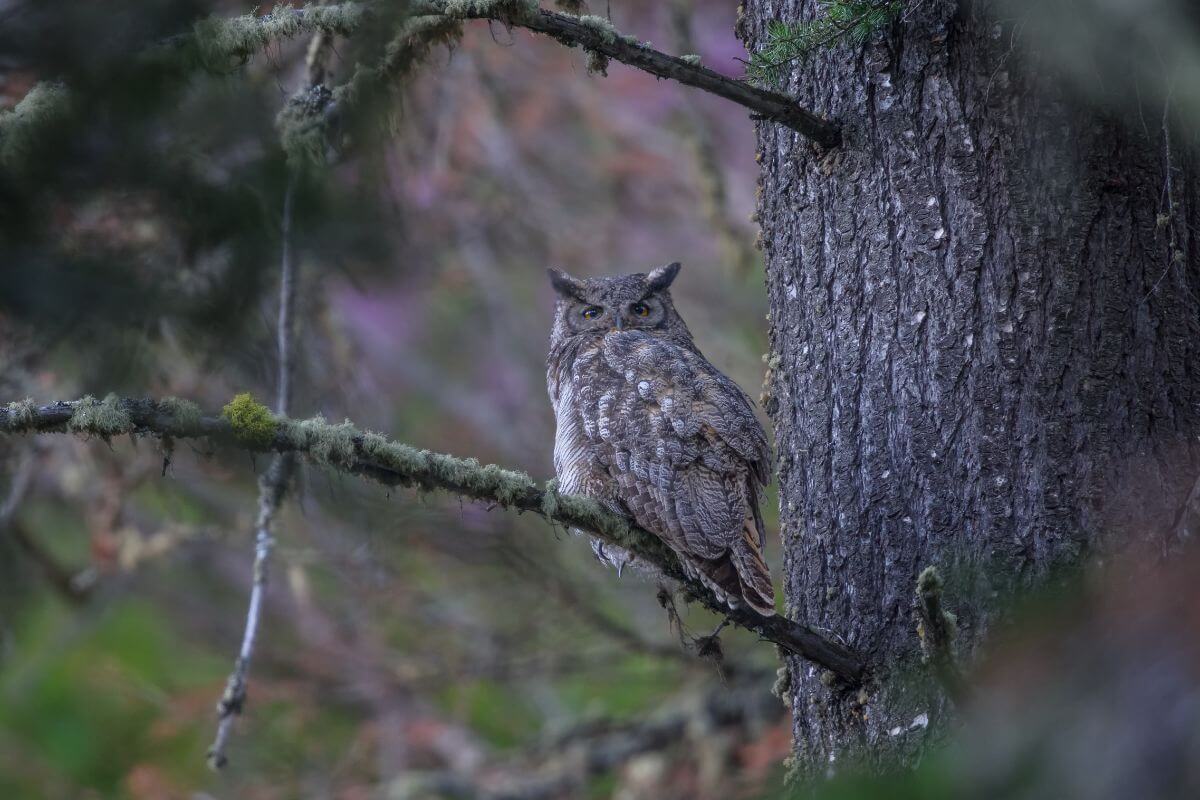
Montana is home to a diverse range of owl species, each adapted to its unique corner of the state. These birds of prey are fascinating to observe and play a crucial role in maintaining the balance of nature. Let’s look at the 15 owl species that call Montana home.
1. Barn Owl
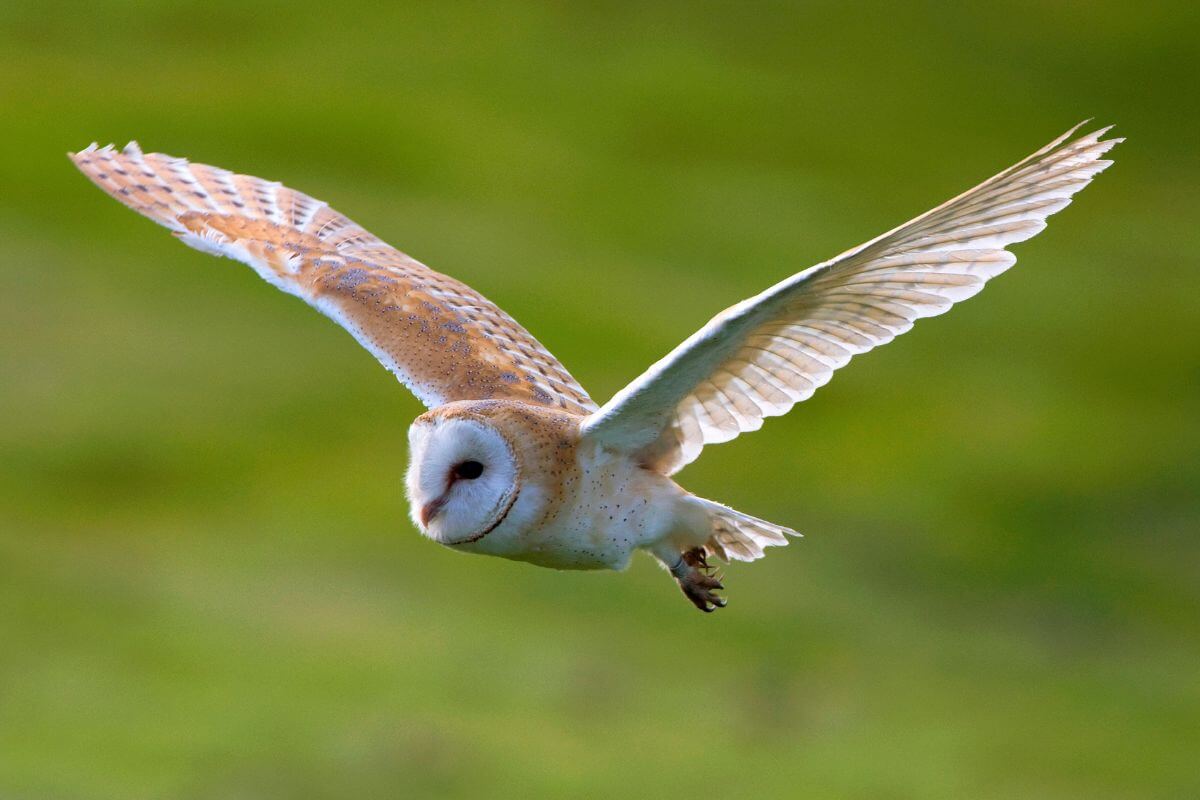
| Key Characteristics | Details |
|---|---|
| Scientific Name | Tyto alba |
| Habitat | Rural areas near agricultural fields and grasslands |
| Food | Small to medium-sized rodents |
| Color | Pale overall with dark eyes |
Barn Owls are medium-sized, with long legs, smoothly rounded heads (without ear tufts), and a distinctive buoyant and loping flight style. Their wings are also round and long, making them easier to spot when they fly.
Montana Barn Owl quick facts:
- The first Barn Owl nest in Montana was found in 1989 in Carbon County near Joliet.
- Barn Owls have a white, heart-shaped face with dark eyes. They also have light breasts and tawny-buff backs to help distinguish them from other owls.
- Barn Owls are known for their long hissing shriek and a unique advertising call that sounds like a drawn-out raspy screech.
- Barn Owls come in many varieties worldwide, with the North American type being the largest.
Finding a Barn Owl in Montana is rare, with fewer than 15 sightings in the state. Listen for its eerie calls to see or hear one. Barn owls prefer quiet places like old barns and buildings.
Barn Owl numbers are decreasing in some areas because they’re losing their homes due to changes in where they live and where they find food. It’s a reminder of how important habitat quality is for all creatures, even those as adaptable as Barn Owls.
2. Barred Owl
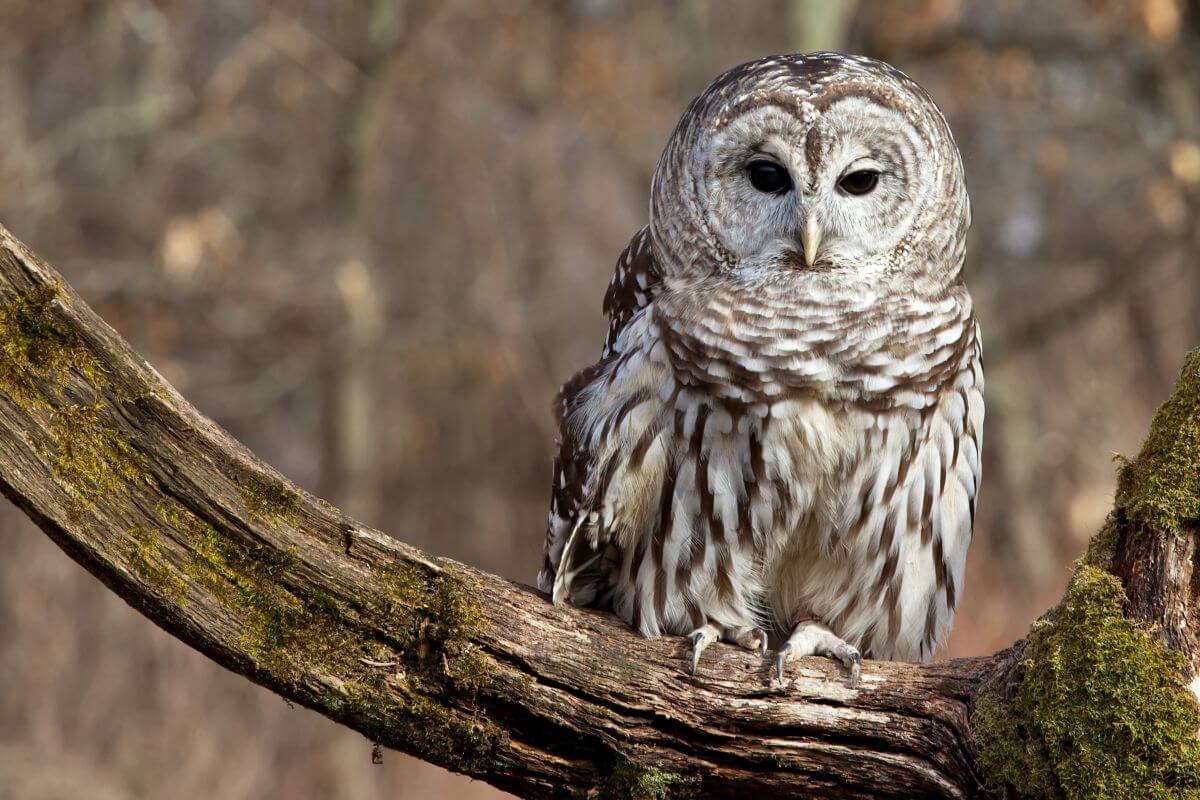
| Key Characteristics | Details |
|---|---|
| Scientific Name | Strix varia |
| Habitat | Wet areas and deep woods |
| Food | Small to medium-sized mammals and birds |
| Color | Mottled brown and white overall |
Barred Owls are known for their robust build, round heads without ear tufts, and medium-length, rounded tails. These owls are easier to hear than see, with a distinctive call that echoes through the trees. If you hear a loud “Who, who, who-whoo” in the distance, the Barred Owl lets you know it’s there.
Barred Owl key facts:
- The first Barred Owl nest was discovered in Montana in 1976.
- Despite their size and power, Barred Owls face a serious threat from Great Horned Owls.
- Barred Owls are not known for mobility and do not travel long distances during migration.
- Barred Owls have a generalized range that includes forests near water. Big bottomland forests along rivers are like five-star hotels for Barred Owls.
For those interested in spotting a Barred Owl, their call is unique and carries far. Try imitating it and waiting quietly. You might just have a Barred Owl swoop in to check out the new voice in its territory.
3. Boreal Owl
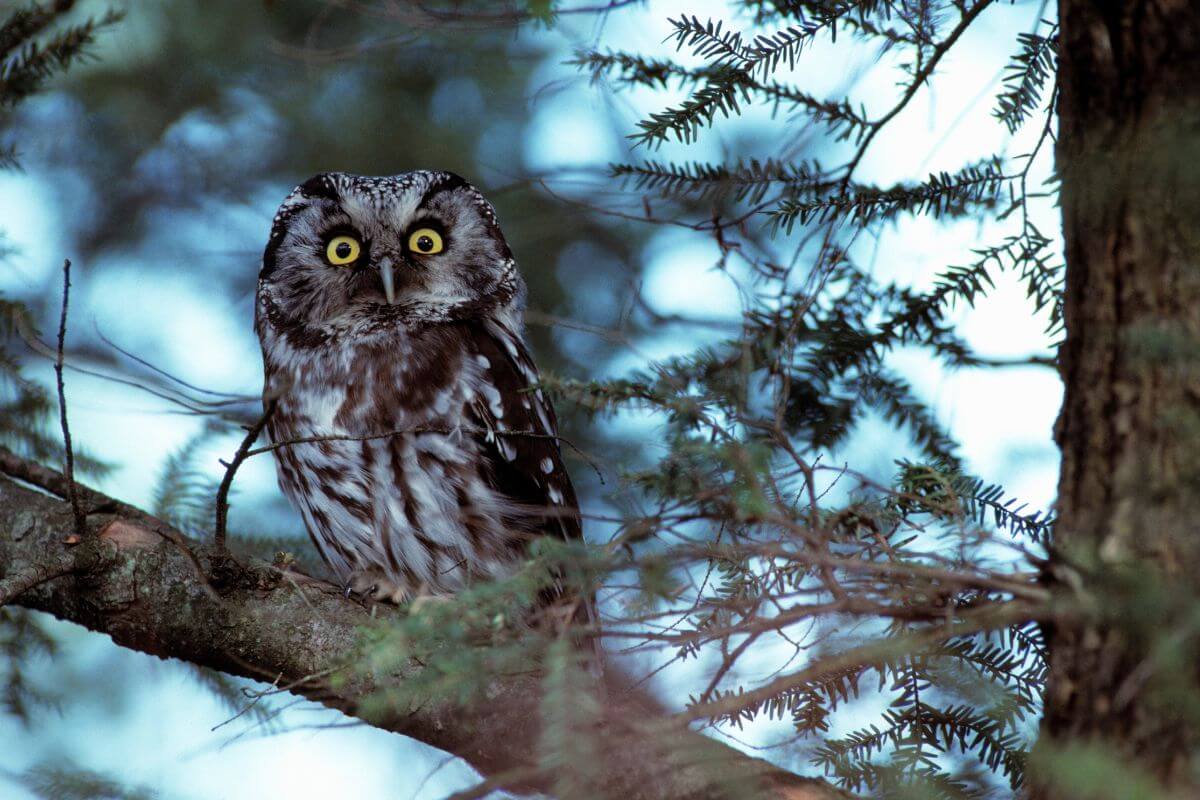
| Key Characteristics | Details |
|---|---|
| Scientific Name | Aegolius funereus |
| Habitat | High-elevation spruce/fir forest |
| Food | Small mammals with a few birds and insects |
| Color | Brown overall with white spots and brown streaks |
The Boreal Owl is a small owl that stands out for its unique features, such as its large square head without ear tufts, robust body, and short tail. These characteristics make it easily recognizable once you know what to look for.
However, it’s often mistaken for the Northern Saw-whet Owl because of its similar looks. The key to telling them apart is in their sound. The Boreal Owl has a distinctive call: a rapid series of short, high-pitched “hoo”s that form a trill that gets louder as time passes.
Boreal Owl fascinating facts:
- Discovery – The first Boreal Owl nest site in Montana was found in 1988.
- Status – The Department of Fish, Wildlife, and Parks considered listing the Boreal Owl as a species of concern.
- Size – In Boreal Owls, the females are notably larger than the males.
Mid-February to April is a great time to observe and listen to Boreal Owls. This period sees an increase in their vocalizations, making it easier to detect them despite their usually silent nature. Since they are active at night, going out after dark is essential to hear their calls.
Understanding their habitat associations can also enhance your chances of encountering them during this time. Boreal Owls typically inhabit high-elevation forests, particularly those with a mix of spruce and fir trees. Look for areas with ample tree cover and suitable prey populations.
4. Burrowing Owl
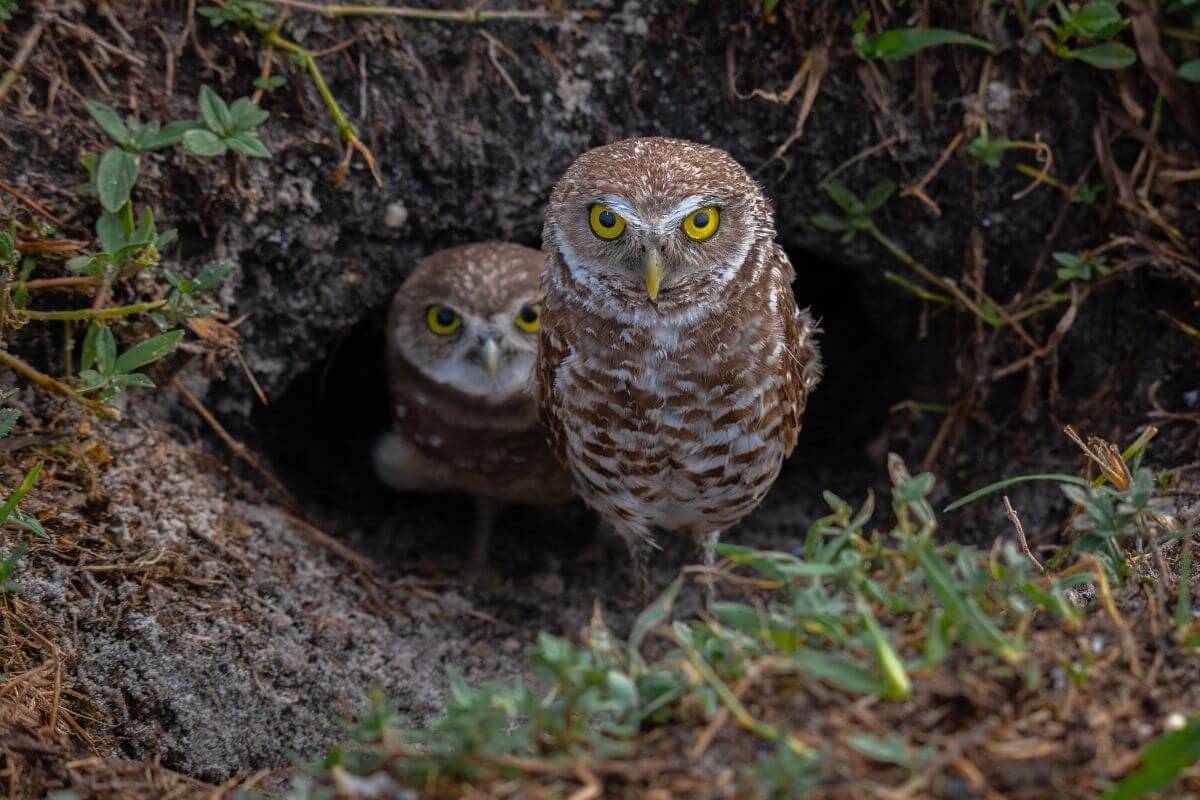
| Key Characteristics | Details |
|---|---|
| Scientific Name | Athene cunicularia |
| Habitat | Open grasslands |
| Food | Invertebrates and small mammals |
| Color | Brown birds mottled with sandy-pale spots |
Burrowing Owls are unique because of their ground-dwelling behavior. They live in underground burrows that have either dug themselves or taken over from other animals. They are also distinguished by their long legs, bright yellow eyes, and round heads without the typical ear tufts of other owls.
Sadly, these owls are struggling because people are changing where they live. Also, the decline of prairie dogs and ground squirrels has led to a big drop in the number of Burrowing Owls.
Burrowing Owl essential facts:
- Vocalizations – The male Burrowing Owl makes a high-pitched “coo-coo” sound, almost like a trumpet. The female responds with a short, clear “eeep” or a rough “ksshh.”
- Food Stash – Burrowing Owls are great at hiding food. Some have been found with over 200 rodents stored away.
- Breathing Easy – Burrowing Owls can handle more carbon dioxide, which helps them when they’re deep in their burrows.
Burrowing Owls’ super camouflage and smaller size than their wide-open habitat make them tricky to spot, so a spotting scope can help. The best times to see them are early morning or late evening when they are most active.
5. Eastern Screech-Owl
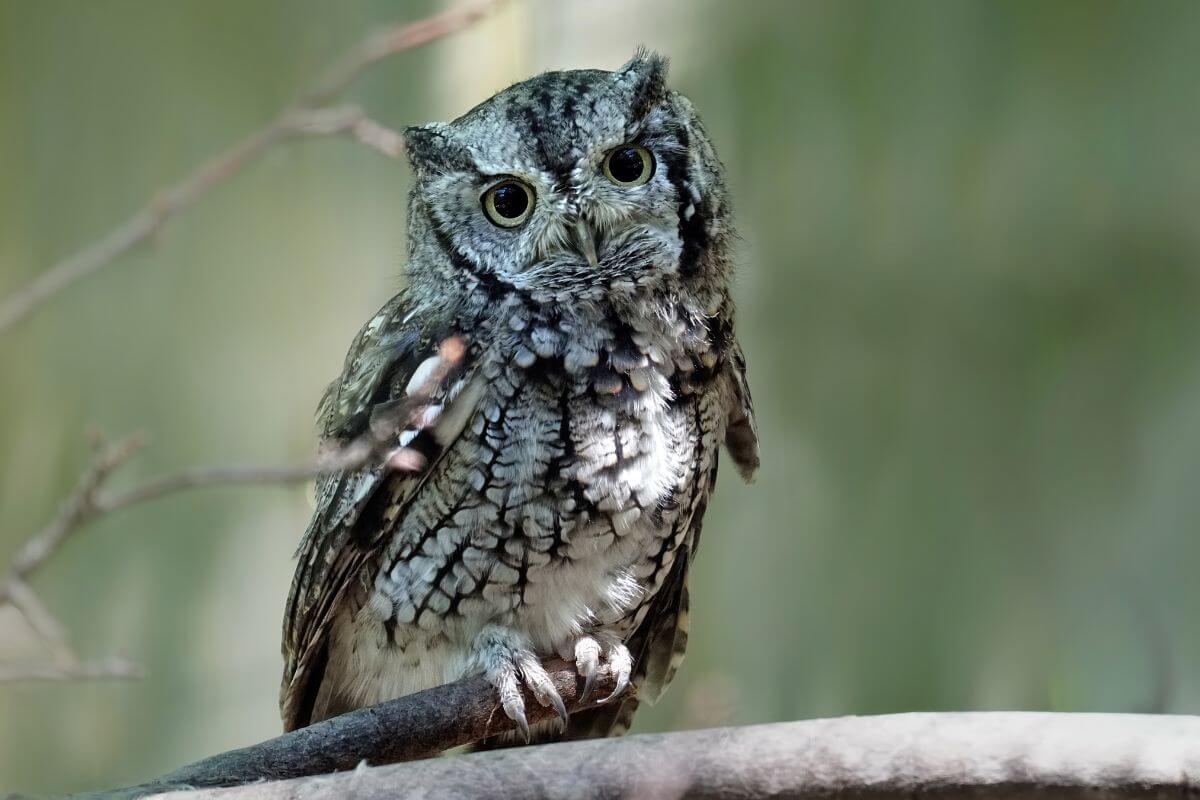
| Key Characteristics | Details |
|---|---|
| Scientific Name | Megascops asio |
| Habitat | Cottonwood bottoms |
| Food | Small mammals and a few birds |
| Color | Either mostly gray or mostly reddish-brown (rufous) |
The Eastern Screech-Owl is a short and stocky bird with a unique look. It boasts a large head, almost no neck, rounded wings, a short tail, and distinctive ear tufts. But what’s fascinating is its voice.
You’ll be greeted by a two-part call when you hear an Eastern Screech-Owl. The first part is a quavering, drawn-out whistle that sounds like “Wheeeee,” similar to a horse’s whinny. This is followed by a vibrating low whistle, “Quohohoho,” all run together in a short, eerie call.
Quick facts about Eastern Screech-Owls:
- Size and Similarity – The Eastern Screech-Owl is almost the same size as the Western Screech-Owl, with the Western species slightly larger.
- Red and Gray Individuals – Most Eastern Screech-Owls are red or gray, with approximately one-third being red.
- Nesting Challenges – Nesting Eastern Screech-Owls face fierce competition for food, which sometimes leads to siblicide, especially in tough breeding conditions.
If you’re out in wooded areas at an inky night, listen for the trills and whinnies of the Eastern Screech-Owl. During the day, you can catch them sunning themselves in tree cavities or nest boxes. This is especially common on cold, sunny days, and it’s a chance to see these nocturnal hunters in a more relaxed state.
The Eastern Screech-Owl’s story is also a tale of adaptation and the availability of habitat. Despite facing challenges like nest competition, they have found ways to thrive. This resilience is a natural lesson about the importance of a safe and suitable home.
6. Flammulated Owl
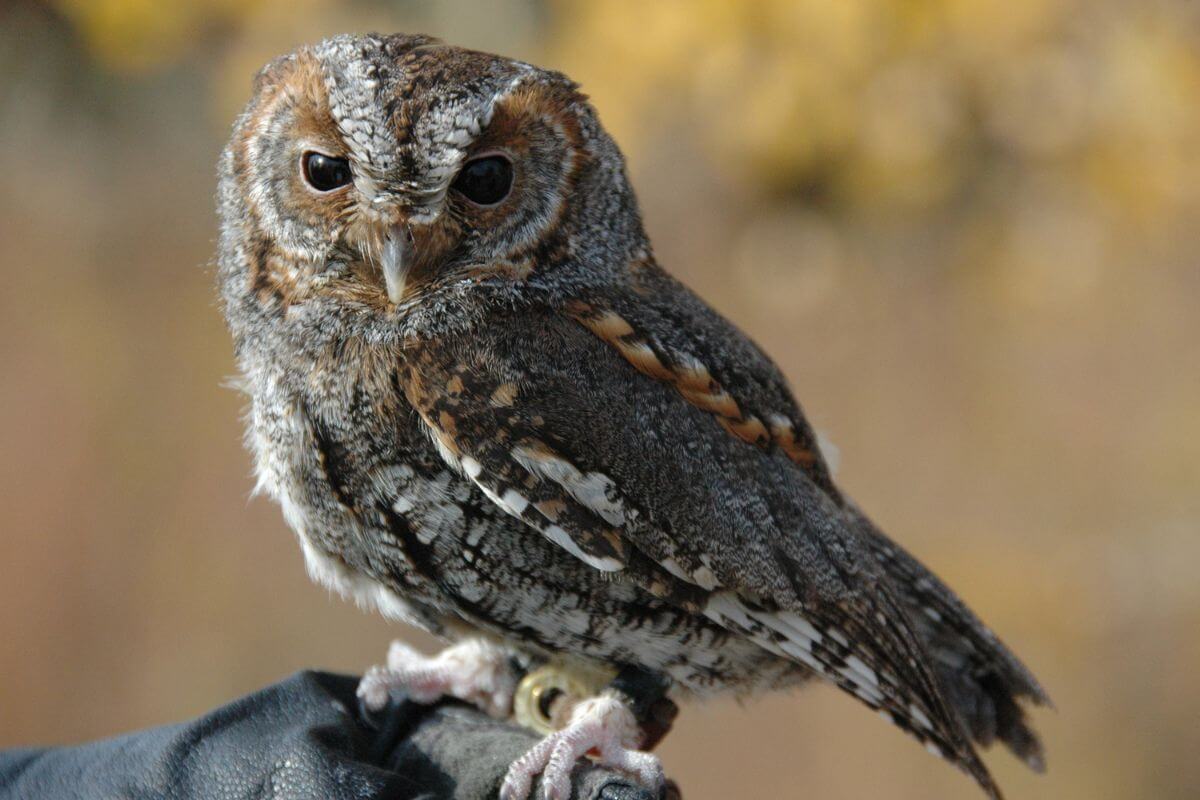
| Key Characteristics | Details |
|---|---|
| Scientific Name | Psiloscops flammeolus |
| Habitat | Mature and old-growth xeric Ponderosa Pine/Douglas-fir stands |
| Food | Almost entirely insects |
| Color | Gray, brown, rust, and white |
One of the smallest owls in North America, the Flammulated Owl is a remarkable creature that thrives in Montana’s diverse landscapes. Despite its tiny size – just 6.75 inches long and 60 grams in weight – this owl has some big features that set it apart.
Flammulated Owl essential facts:
- Sound – Flammulated Owls are often heard before they are seen. The male’s call is a soft, low-pitched hoot like “poop” or “pooip,” repeated every few seconds. The females have a more intricate call, higher pitch, and quavering quality.
- Eyes – The dark eyes of the Flammulated Owl are a signature feature, setting it apart from other owls of similar size in North America.
- Discovery – A woodcutter discovered the first nest of Flammulated Owls in Montana in 1986.
Encountering a Flammulated Owl in the wild is a special experience, one that requires patience and respect for these nocturnal species. Using imitations of their calls to draw them near can work, but it’s important to keep these nighttime visits short to avoid disturbing them.
In a state as rich in natural beauty as Montana, the Flammulated Owl is a testament to the incredible diversity of life that exists across its array of habitats.
7. Great Gray Owl
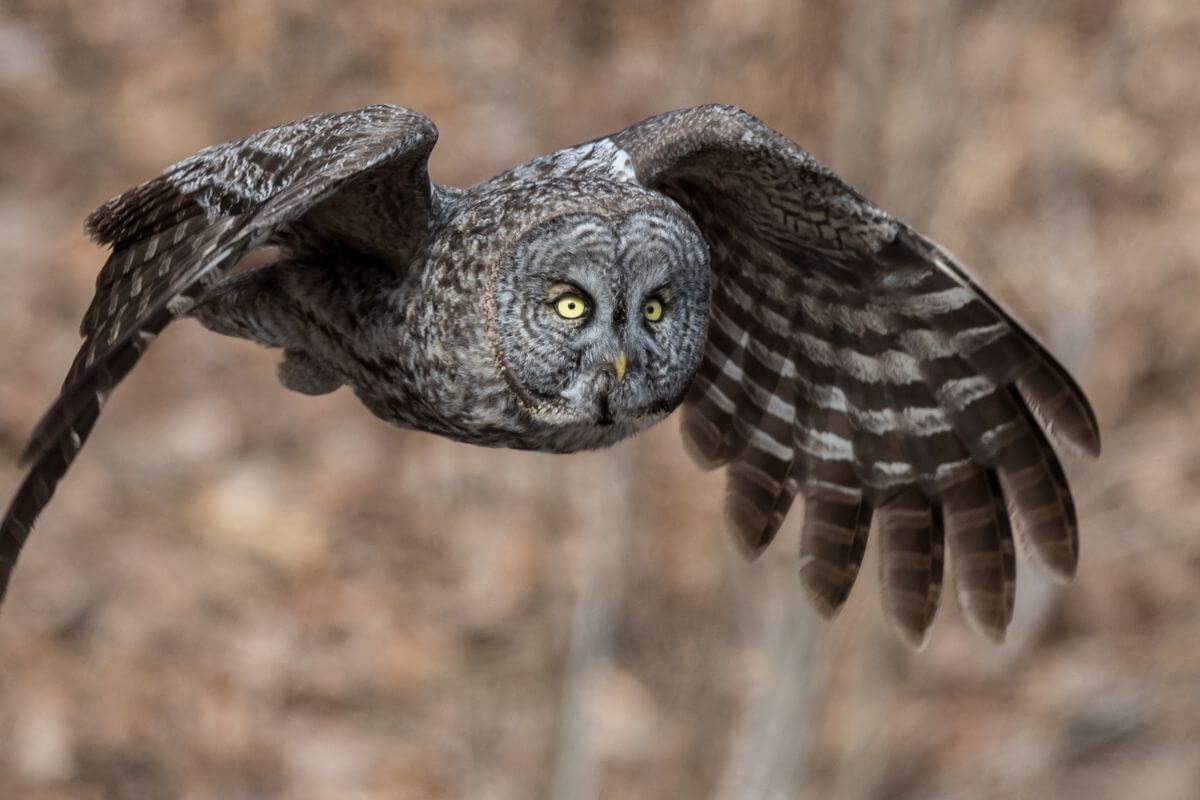
| Key Characteristics | Details |
|---|---|
| Scientific Name | Strix nebulosa |
| Habitat | Dense forests |
| Food | Small rodents |
| Color | Silvery gray overall |
The Great Gray Owl is the largest in North America. It has a wingspan of over 4 feet, a body that can reach 27 inches, and a weight of more than 2 pounds. When you spot one, you’ll immediately notice its distinctive appearance — it looks as if it’s wearing a gray suit with a bow tie across its neck and a face that always looks surprised.
You’ll hear it when the Great Gray Owl decides to speak up. Their vocalization is unique, a deep series of “whoos” that changes in pitch and gets faster as it goes on.
Great Grey Owl characteristics:
- Hunting Prowess – Despite weighing only 2.5 pounds, Great Gray Owls are incredibly skilled hunters. They can dive into hard-packed snow to catch small mammals.
- Diet – In the winter, Great Gray Owls feast on up to 7 vole-sized mammals daily.
- Size Comparison – Despite their hunting skills and unique features, Great Gray Owls are still just a ball of feathers compared to other owl species like the Great Horned Owl and Snowy Owl. These larger owls have bigger feet and talons that outweigh the Great Gray Owl.
Even though they’re so big, Great Gray Owls are hard to find in the vast Montana outdoors. Your best chance to spot one is during an irruptive year when they come further south searching for food.
Because they are sensitive to disturbance, it is important to enjoy them from a distance. Avoid using calls or mice to attract them, as this can disrupt their natural behavior.
8. Great Horned Owl
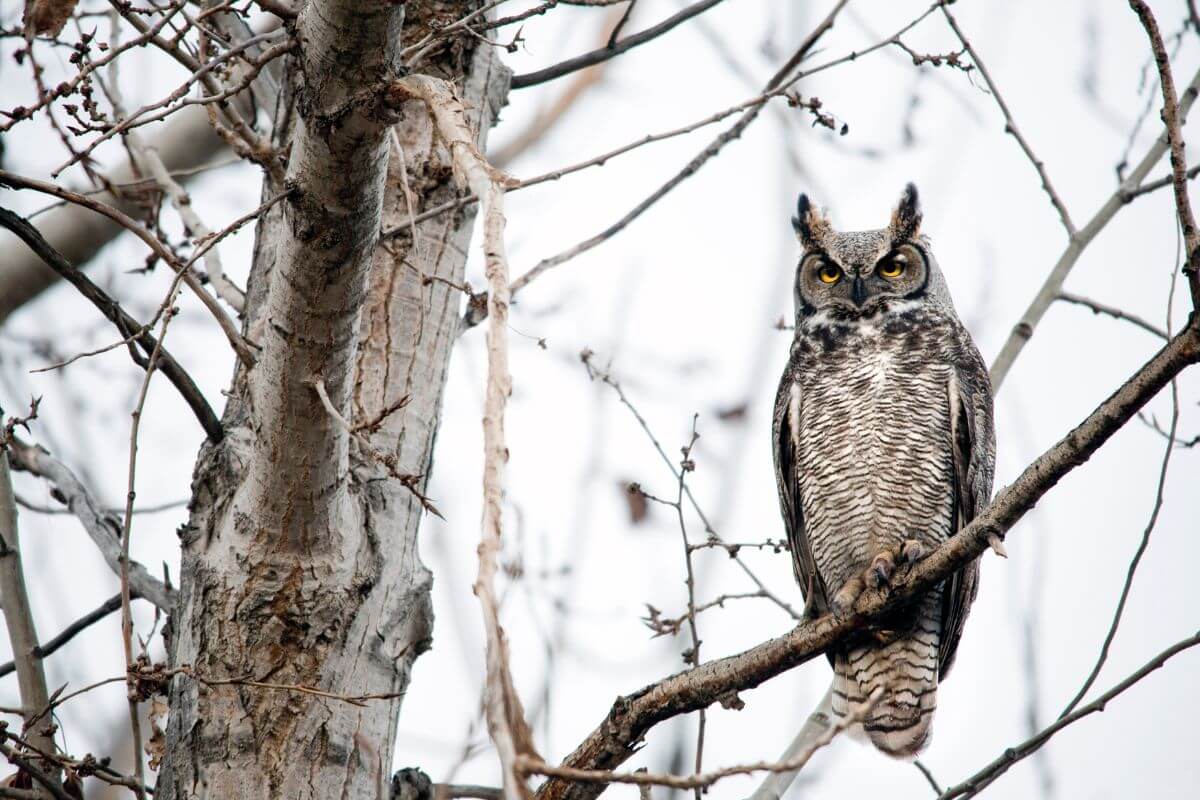
| Key Characteristics | Details |
|---|---|
| Scientific Name | Bubo virginianus |
| Habitat | River bottoms to timberline |
| Food | Small to medium-sized mammals and birds |
| Color | Mottled gray-brown with reddish-brown faces |
The Great Horned Owl is the most common in the U.S. It is a large, thick-bodied owl with two big tufts of feathers on its head and wide, round wings. It is famous for the classic owl sound we all know. Its voice is a booming “Whoo, whoo, whoo whooo, whooo-whooo” that you can’t miss.
Great Horned Owl essential details:
- Hunting Skills – Great Horned Owls are top hunters, with a grip so strong it takes 28 pounds of force to open their talons. They use this strong grip to quickly kill their prey by severing the spine.
- Enemy – American Crows don’t like Great Horned Owls. When they see one, they team up from all around to bother it. They keep at it for hours because they know the owl is a big threat.
- Eyes of the Night – Great Horned Owls are built for the dark with huge eyes, wide pupils, and great night vision. Their eyes have lots of rod cells, which help them see in low light.
- Wide-Ranging – The Great Horned Owl calls many places home. It has the largest range of any owl in the Americas.
Great Horned Owls are creatures of the night. You’re most likely to see them at dusk, perched on fence posts or tree limbs at the edge of open areas. You’ll notice their stiff, deep wingbeats when they take to the sky as they cross roads or fields.
If you want to watch Great Horned Owls from home, there’s a live cam near the Ninepipes Wildlife Refuge in Charlo, Montana. This cam lets you see the owls in their natural habitat, where they nest yearly. You can watch them here.
9. Long-Eared Owl
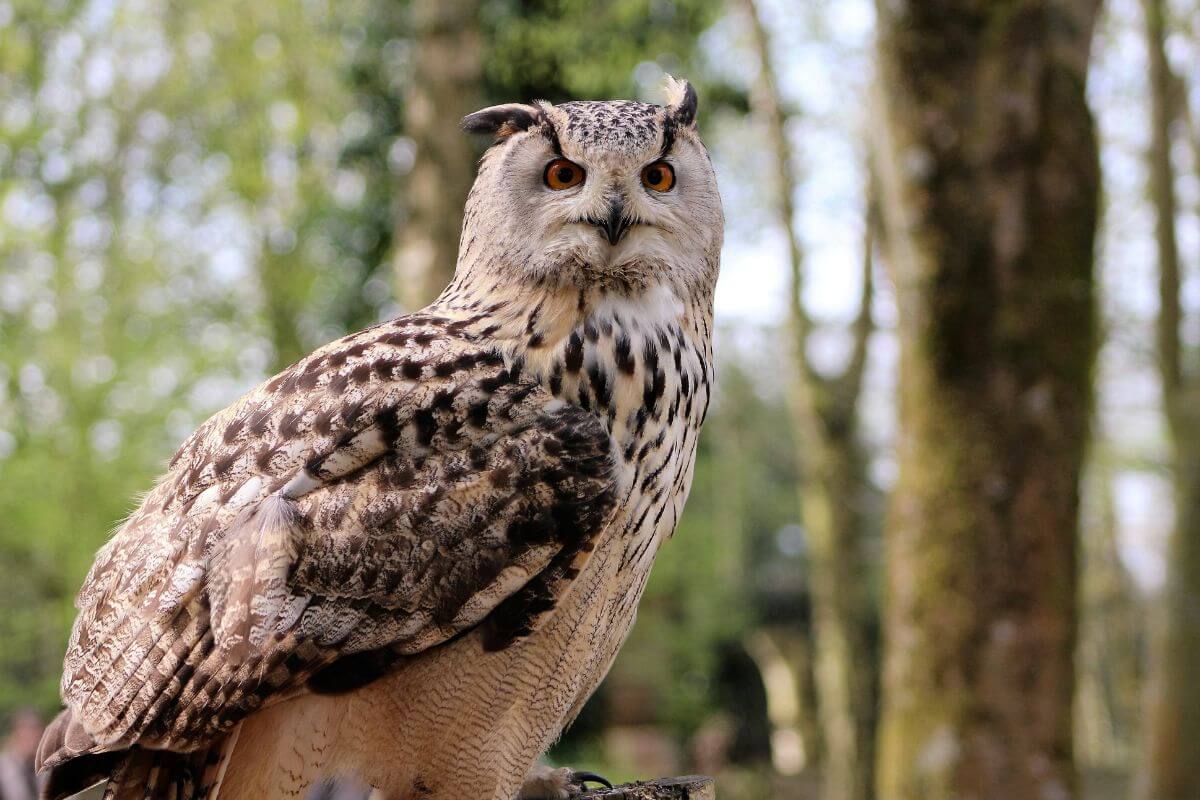
| Key Characteristics | Details |
|---|---|
| Scientific Name | Asio otus |
| Habitat | Hedgerows, woody draws, and juniper thickets |
| Food | Small rodents |
| Color | Fairly dark birds with buff or orange faces |
Long-Eared Owls are amazing birds that stand out in the owl kingdom with their unique features and behaviors. These medium-sized owls are known for their slender bodies, squarish heads, and long and narrow faces. As their name suggests, they have long ear tufts that point straight up.
You might catch the soft, rhythmic sound of a Long-Eared Owl’s call when you’re out in the evening. A gentle “Hoo, hoo, hoo” repeats every few seconds. This vocalization is so distinctive that it can help you identify these owls even if you can’t see them.
What makes Long-Eared Owls unique?
- Flying and Hearing – Long-Eared Owls can fly silently and with great precision. Thanks to their keen hearing, they can pick up the tiniest sounds of their prey even on the quietest nights. This skill, combined with their agile flying, makes them formidable hunters.
- Hooting – Male Long-Eared Owls have another talent: they can hoot loudly and for a long way. Their hoots can travel up to a kilometer (0.7 miles) in the still night air.
Finding Long-Eared Owls isn’t always easy. They love their privacy and are most active at night. But if you listen carefully during spring and summer, you might hear their low hoots. In winter, you might spot them roosting in groups, which offers a rare chance to see these secretive birds up close.
10. Northern Hawk Owl
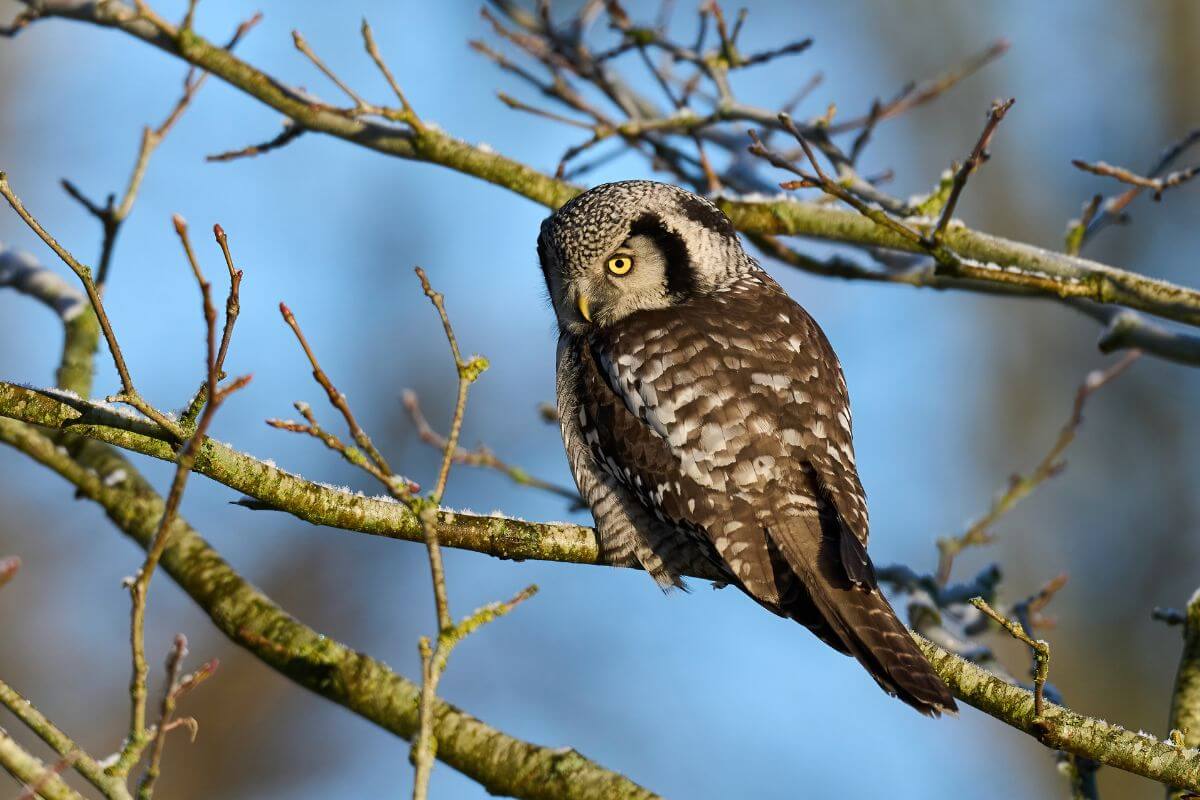
| Key Characteristics | Details |
|---|---|
| Scientific Name | Surnia ulula |
| Habitat | Moderately dense coniferous or mixed coniferous-deciduous forests |
| Food | Small mammals |
| Color | Brown above with white spots |
The Northern Hawk Owl is a fascinating bird species that blurs the lines between owls and hawks. When you see one, you might think it’s an owl, but its daytime hunting and perching habits are more like a hawk’s.
The Northern Hawk Owl stands out with its oval body, yellow eyes, and a face that looks like it’s framed by dark parentheses, all set on a hawk-like long tail. It’s a creature of contrasts, perching proudly on the tops of trees by day and hunting with the keen eyesight of a hawk.
The Northern Hawk Owl ensures its presence is known during the breeding season. The male belts out a unique call that can last up to 14 seconds, a trilling, rolling whistle of “ululululululul.” Though shorter and less rhythmic, the female’s call serves the same purpose, with a hoarse, shrill quality that’s unmistakable.
Northern Hawk Owl essential details:
- Sight Hunter – The Northern Hawk Owl can spot prey with its sharp eyes from up to half a mile away, relying heavily on its vision for hunting. While this owl is most active during the day, it doesn’t stop hunting at night.
- Rare Find – The Northern Hawk Owl is not a common sight due to its small population and specific habitats in Montana.
The Northern Hawk Owl roosts in tree branches close to the trunk and hides among the leaves at night, posing a challenge to those trying to locate them. This behavior is a survival tactic, keeping them safe from nocturnal predators.
11. Northern Pygmy Owl
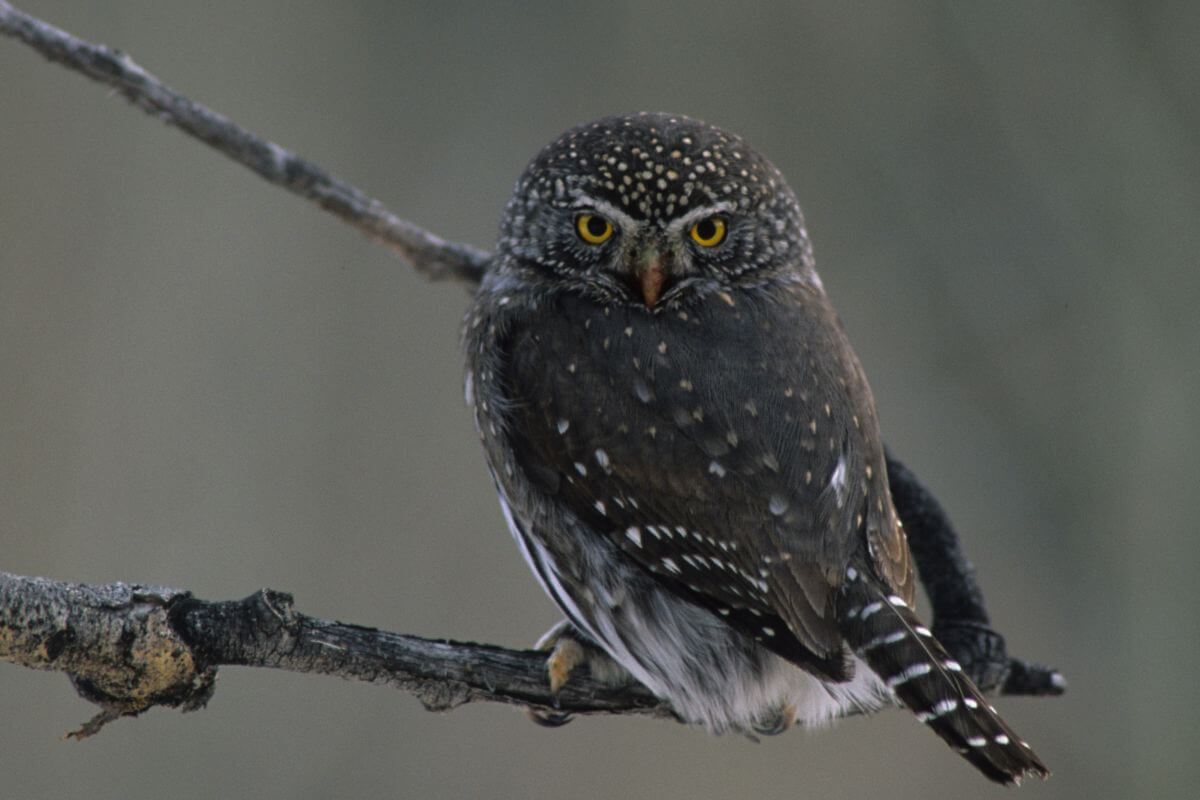
| Key Characteristics | Details |
|---|---|
| Scientific Name | Glaucidium gnoma |
| Habitat | Mixed fir forests |
| Food | Small birds, mammals, insects |
| Color | Brown with fine white speckles |
The Northern Pygmy Owl is a remarkable creature. It is small but mighty in the hunt and has a particular taste for songbirds. It is mostly dark brown and white, with long tails, rounded heads, and striking yellow eyes.
Northern Pygmy Owl intriguing facts:
- Song – The Northern Pygmy Owl’s song is a series of high, hollow “toots” spaced about 4 seconds apart. This distinctive song is often sung by both males and females, with females having a slightly higher pitch. After the song, they have a rapid, high-pitched trill call.
- Defensive Strategy – Northern Pygmy Owls are known for their defensive tactic of raising tufts on the sides of their heads when threatened.
- Predation – Despite their small size, Northern Pygmy Owls can take on prey up to three times their size, including birds like the Northern Bobwhite and the Northern Flicker.
Due to their daytime activity and widespread distribution, spotting them is more about being attentive than about luck.
Here are some tips to increase your chances of spotting a Northern Pygmy Owl:
- Observe – The Northern Pygmy Owl’s small, camouflaged presence requires keen observation.
- Listen – Pay attention to the Northern Pygmy Owl’s tooting calls. Also, as a sign of the Northern Pygmy Owl’s presence, watch for groups of noisy songbirds.
The Northern Pygmy Owls’ habitat relationships are fascinating, especially their interaction with other birds and their prey. Despite their size’s challenges, their unique strategies make them successful hunters.
12. Northern Saw-Whet Owl
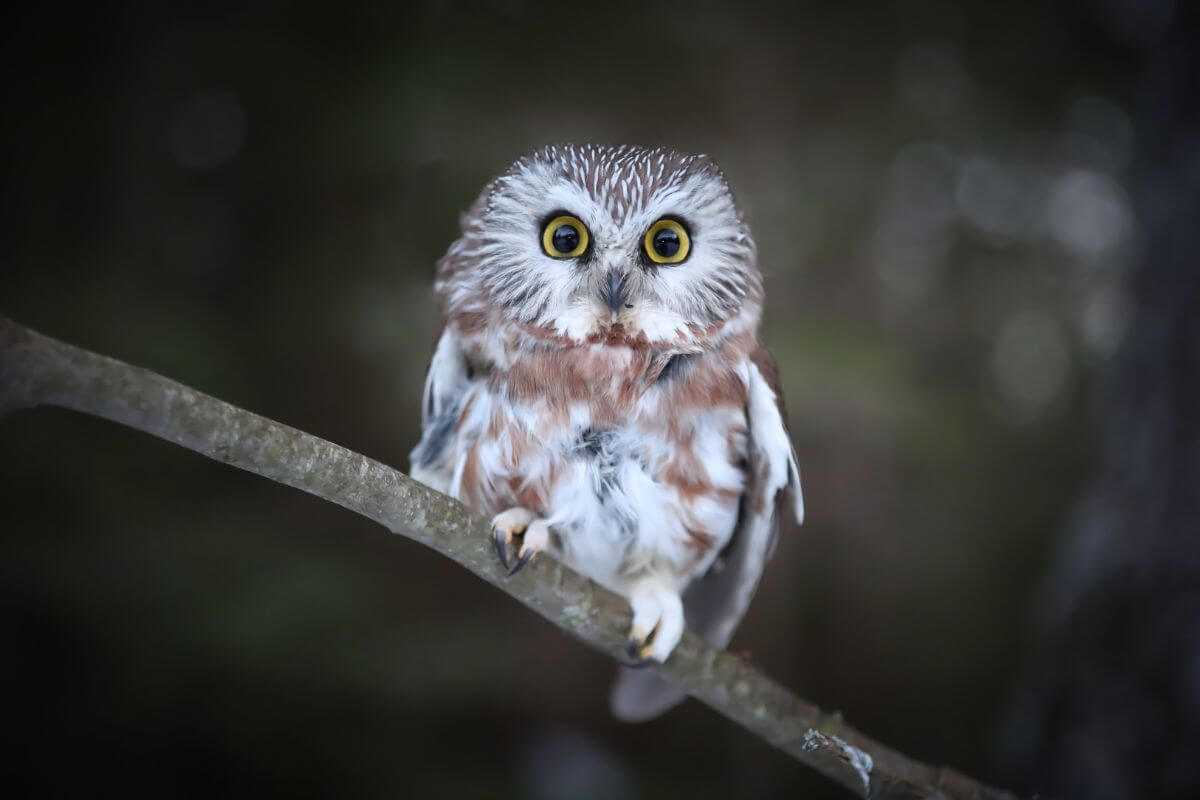
| Key Characteristics | Details |
|---|---|
| Scientific Name | Aegolius acadicus |
| Habitat | Conifer forests |
| Food | Small mice |
| Color | Mottled brown with a whitish facial disk and white-spotted head |
Northern Saw-Whet Owls are tiny, and when you see them, you’ll notice their big, round heads, which lack the typical ear tufts. This gives them a similar look to a cat, with their bright yellow eyes set in an oversized head.
When making themselves heard, the Northern Saw-Whet Owls are quite vocal. The night is filled with “Toot, toot, toot,” repeated quickly and steadily. This call, which sounds like a saw being sharpened on a whetting stone, is where they might have gotten their name, “Saw-whet.”
Northern Saw-Whet Owls interesting facts:
- Nesting Habits – Female Northern Saw-Whet Owls are very clean around their nests. They ensure everything is tidy, but things can get messy when they’re not there.
- Migration Mystery – Figuring out where Northern Saw-Whet Owls go during different times of the year has been tough. They’re active at night and like to keep to themselves, making it hard to track their movements.
Seeing a Northern Saw-Whet Owl is not easy as they’re good at blending in with their surroundings. However, if you’re in a quiet forest in northern or western North America from January to May, you might just hear that distinctive call. Listening out to them is a much more reliable way to know they’re around.
13. Short-Eared Owl
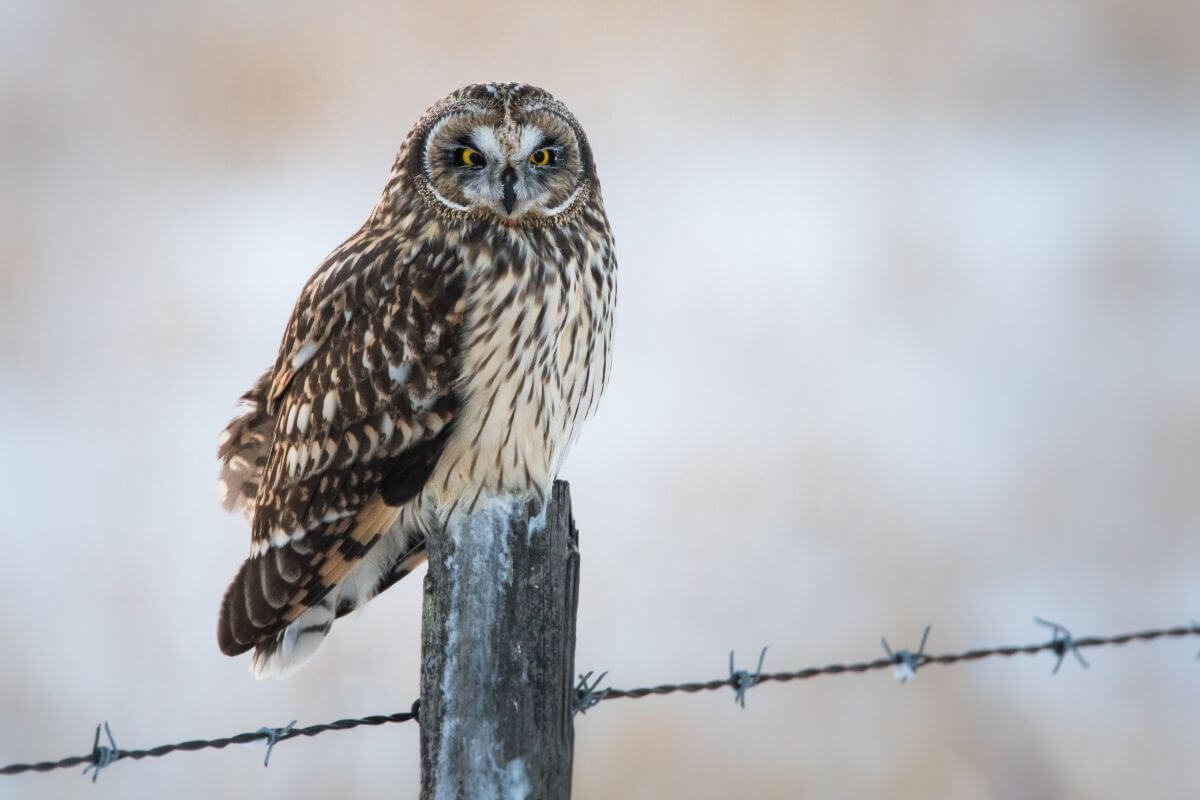
| Key Characteristics | Details |
|---|---|
| Scientific Name | Asio flammeus |
| Habitat | Open grasslands, plains, and agricultural areas |
| Food | Vole or field mouse |
| Color | Medium brown spotted with buff and white |
The Short-Eared Owl is a small to medium-sized owl with exceptional flying skills and long wings. This owl is not your average night flyer. It’s one of the most widely distributed owls around the globe and loves to show itself during the day, especially in open areas.
When you’re out and about in Montana, keep an eye (and ear) out for the Short-Eared Owl. You might hear its unique call, a mix of low hoots and yaps. During courtship, this owl gets all romantic, singing its special “voo, hoo, hoo, hoo” tune, often mid-flight, and throwing in some wing claps and dives for good measure.
Short-Eared Owls key facts:
- Flight Style – A Short-Eared Owl in flight looks like a mechanical moth, sloppy and slow.
- Name Origin – Those tiny tufts of feathers above the Short-Eared Owl’s eyes are why it’s called “Short-Eared.”
- Nesting – When mama Short-Eared Owl has to bail on the nest, she might pull a not-so-pleasant trick, pooping on her eggs to keep predators away or hide the nest smell.
Seeing the ear tufts of a Short-Eared Owl can be a challenge, they’re often so short you won’t spot them. But you will see those striking black-rimmed yellow eyes set in a pale face that’s like a beacon in the night.
14. Snowy Owl
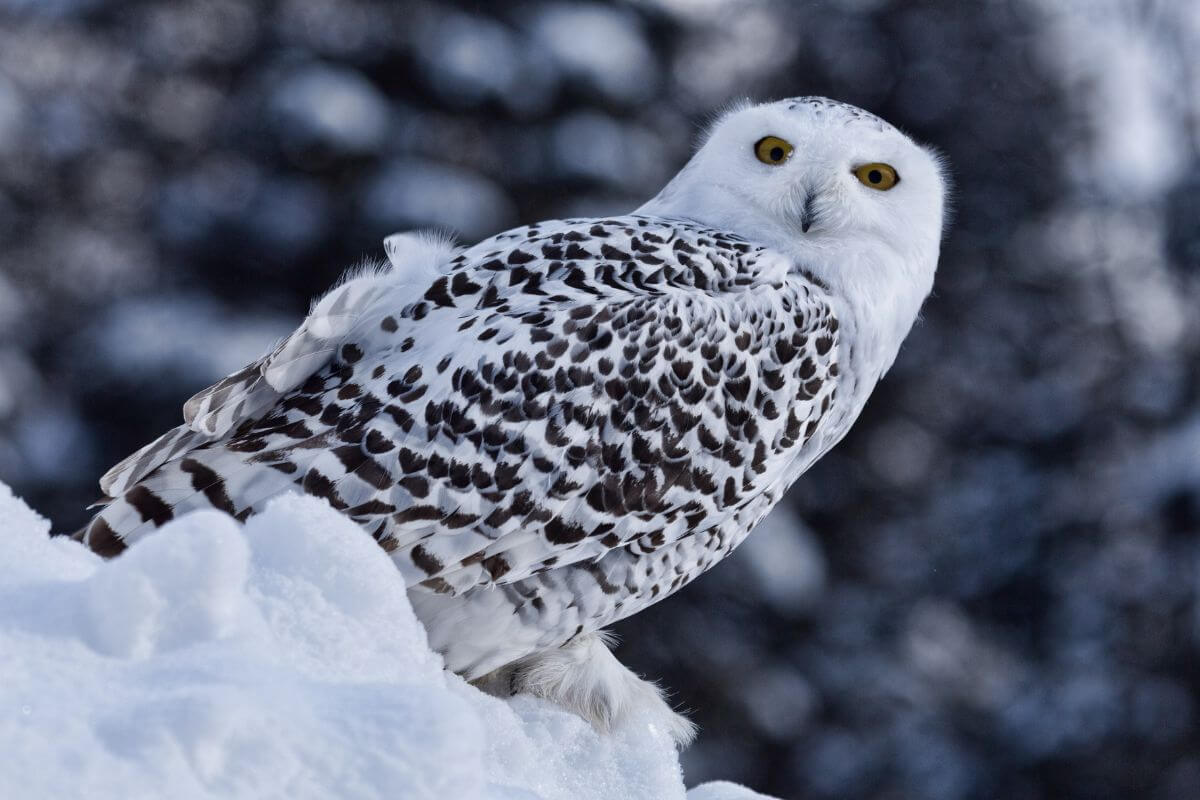
| Key Characteristics | Details |
|---|---|
| Scientific Name | Bubo scandiacus |
| Habitat | Breeds on Arctic tundra |
| Food | Voles and lemmings |
| Color | White birds with varying black or brown markings |
The Snowy Owl is the largest North American owl in terms of weight. It’s easy to spot with its large, smoothly rounded head that usually doesn’t have ear tufts. When you see a Snowy Owl sitting, you’ll notice its bulky body and the thick layer of feathers on its legs, making it look wide at the bottom.
Vocalization is a key form of communication for the Snowy Owl, especially during the breeding season. Males are loud, using a deep, booming “hoo, hoo” to mark their territory or attract a mate. On the other hand, females are quieter and rarely join in the hooting.
But that’s not all the sounds they make. It also includes dog-like barks, rattling cackles, shrieks, hissing, and even bill-snapping. It’s a symphony of interesting noises.
Snowy Owls essential information:
- Appearance in Cave Paintings – Snowy Owls have been around for a long time. They’re even featured in ancient cave paintings in Europe.
- Plumage – Young male Snowy Owls start with dark brown markings that turn white as they age. Females keep some of these dark markings their whole lives.
- Eating Habits – A Snowy Owl can devour more than 1,600 lemmings in a year, thanks to its love for hunting in the continuous daylight of Arctic summers.
If you’re eager to spot a Snowy Owl, winter is your best bet. They love wide, open spaces like fields and shorelines. When you’re out looking, focus on snowy, flat areas and any unusual shapes in the snow.
15. Western Screech-Owl
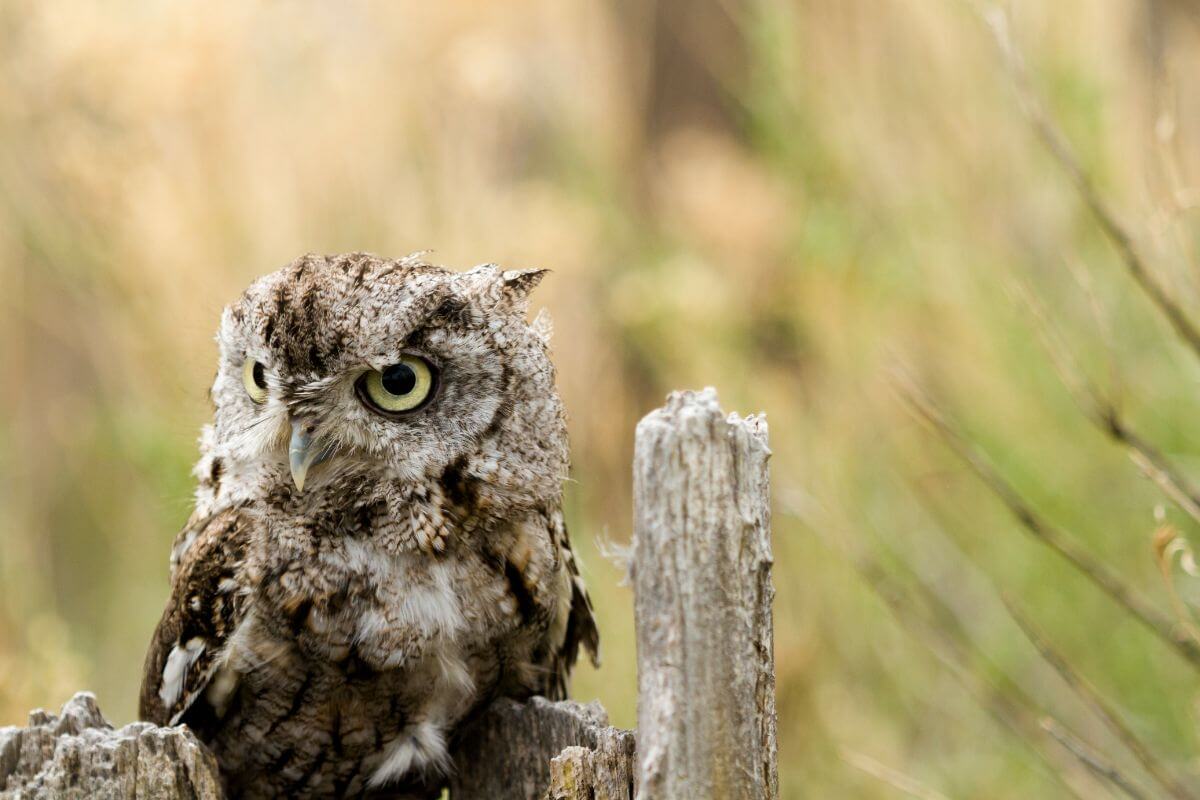
| Key Characteristics | Details |
|---|---|
| Scientific Name | Megascops kennicottii |
| Habitat | Cottonwood bottoms |
| Food | Small mammals and a few birds |
| Color | Grayish, brownish, or reddish-brown |
Western Screech-Owls are small, with stocky bodies and distinctive features. They’re like nature’s compact night watchers, with almost no neck, conspicuous ear tufts, and a short tail.
Their vocal talents are quite impressive, too. Imagine walking through a park and hearing a bouncing ball at night. That’s the first call of the Western Screech-Owl, an accelerating series of “toot, toot, toot toot toot toot.” The second call is a trill, adding to the nocturnal symphony of sounds.
Interesting facts about the Western Screech-Owls:
- Vocal Distinction – Despite their name, Western Screech-Owls don’t screech. It’s a bit of a mix-up, as they produce those unique hollow toots. This sets them apart from their Eastern relatives, who make a screeching sound.
- Daytime Behavior – During the day, Western Screech-Owls perch near their roost holes in trees, keeping a low profile by pressing against them. This behavior helps them stay safe and unseen.
- Habitat Adaptability – Western Screech-Owls live in various places, from urban parks to wild spaces, as long as tree cavities or nest boxes are around.
Listening at night is your best bet if you’re eager to spot a Western Screech-Owl. This experience is not just about spotting an owl, it’s about connecting with nature in the quiet of the night, where the converging ranges of human and animal habitats meet.
Montana Owl-Watching Tips
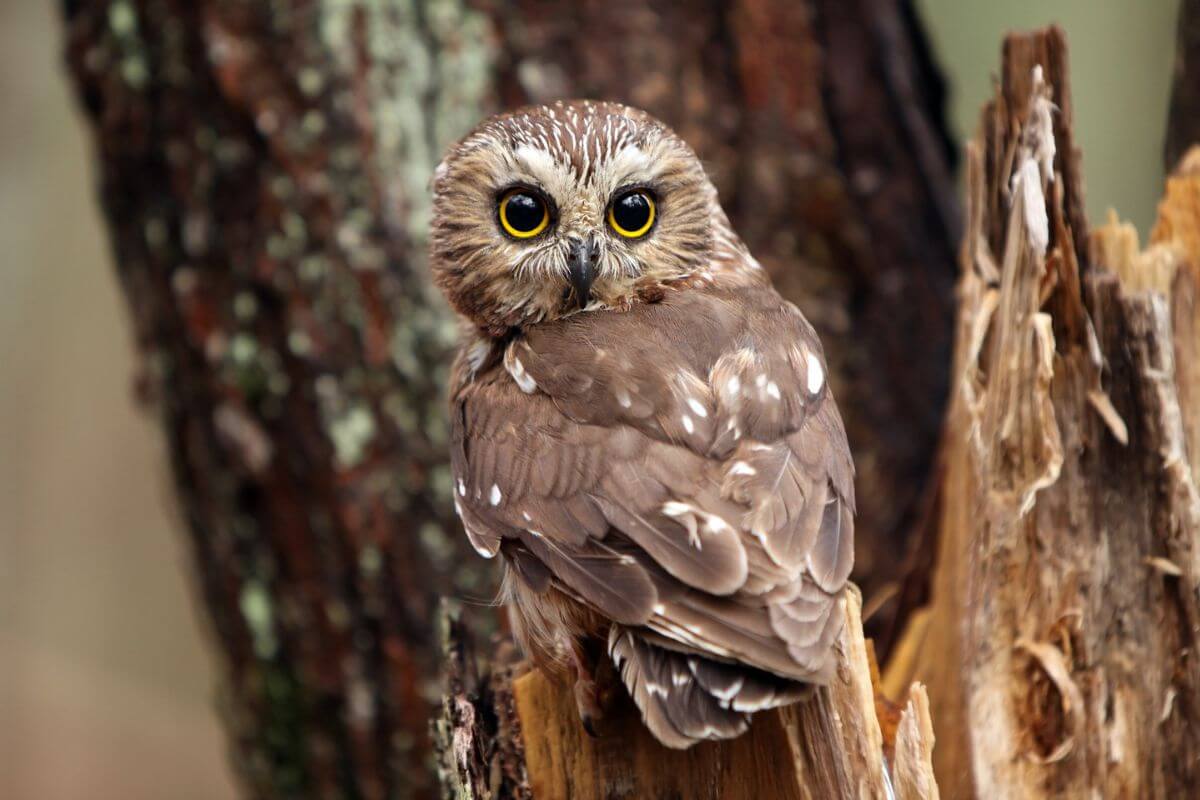
Owling in Montana is a special adventure, perfect for those who love the quiet mysteries of nature. It’s all about listening. Owl calls are soft and low, so you need to tune in just right.
Key tips for a memorable owling experience in Montana include:
- Get to Know the Owls’ Songs – Familiarize yourself with Montana’s owls’ calls before you head out. It’s like learning a new language that connects you to nature.
- Dress Warmly – Late winter and early spring nights can be cold. Dressing warmly keeps you comfortable and lets you focus on the owls, not the chill.
- Equip Yourself – A good headlamp is a must. It helps you navigate in the dark and catch the glint of owls’ eyes.
- Bring a Tape Player – Playing owl calls or mimicry of prey animals can attract owls. But remember to do this carefully so as not to disturb the owls.
- Choose the Right Time – Owls are most active in spring, hunting for their young. Start your owling adventure a couple of hours after sunset. This is when you’re most likely to see them.
The Ninepipe National Wildlife Refuge is a top spot for owl-watching in Montana. It’s home to a variety of owl species. As you enjoy watching these magnificent birds, remember to keep your distance. We should always respect their space to avoid causing them stress.
If you’re curious about the specific owl species you’ve seen or will see, Montana Fish, Wildlife & Parks is a great resource. Their pamphlet, “Identification of Montana’s Owls,” with beautiful illustrations by Joe Thornbrugh, can help you learn more about these fascinating creatures.
Montana Owls Final Thoughts
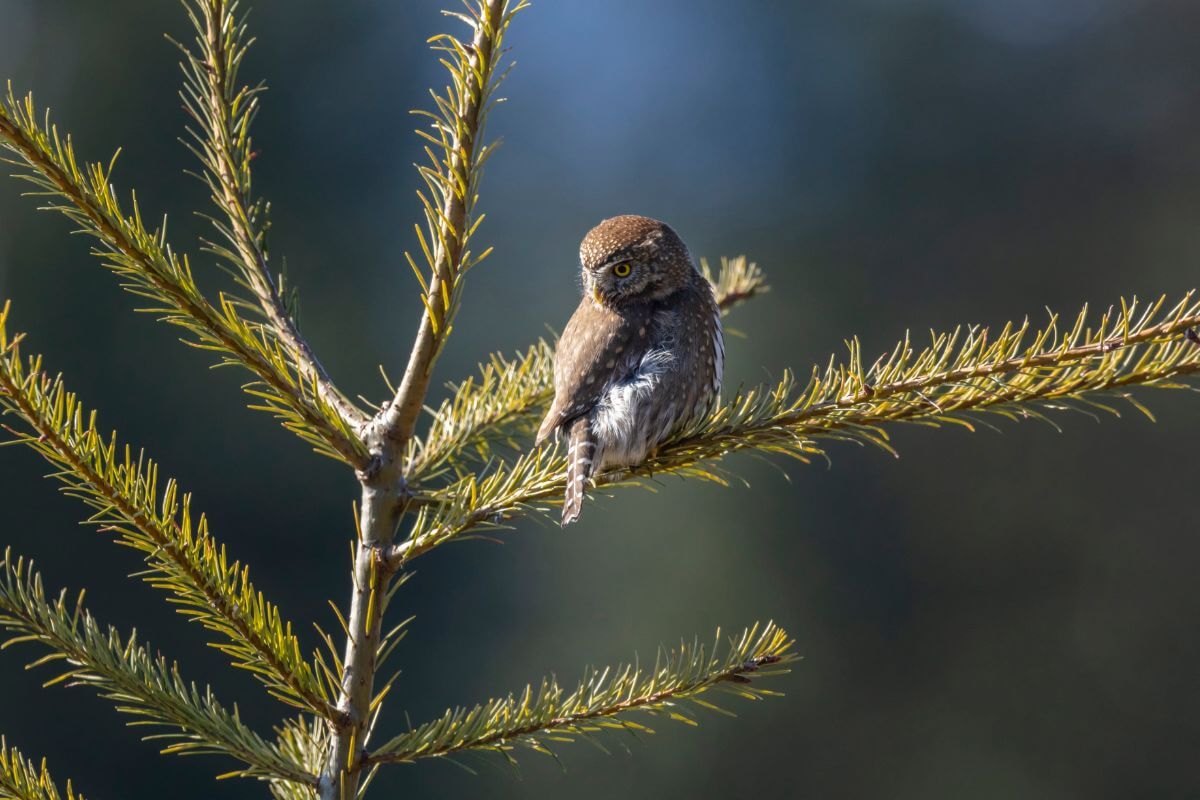
Owls are among Montana’s most intriguing and diverse creatures. Each species, from the elusive Boreal Owl to the majestic Great Gray Owl, tells a story of adaptation and survival in the state’s varied landscapes.
Montana owls are not just symbols of the night but key players in the state’s ecosystem. For anyone captivated by the mysteries of the night sky, Big Sky Country offers a rich canvas on which to observe and appreciate these remarkable birds.
Encountering an owl in Montana’s wilderness is a privilege that comes with the responsibility to ensure their habitats remain safe and undisturbed. Let’s carry forward the lessons these owls teach us, cherishing and protecting the wild spaces they call home.
Montana Owls FAQs
1. What Is the Largest Owl Species in the United States?
The Great Horned Owl is the biggest in the U.S. They are known for their ear tufts and hooting calls.
2. Can You Own a Barn Owl in Montana?
In Montana and other parts of the United States, it’s not legal to keep native owls, such as barn owls, as pets. This protects wildlife and ensures that the owls are well taken care of.
Only licensed individuals, such as wildlife rehabilitators, educators, or researchers, who have the necessary permits and expertise can possess them.
3. How Many Owls Are in Montana?
Montana is home to 15 different owl species. From the common Great Horned Owl to the more elusive Northern Pygmy Owl, each species has its unique preferences for where it lives and how it behaves. This combination of habitat and behavior makes for a diverse and interesting group of owls throughout the state.
4. Does Montana Have Burrowing Owls?
Burrowing Owls can be found in various open habitats across Montana. They prefer living on grasslands and prairies.
5. What Is the White Owl in Montana?
The white owl in Montana is the Snowy Owl, or the Polar or Arctic Owl. These large white owls are native to Arctic regions and occasionally visit Montana during winter.
Explore the world of Montana through these captivating reads:
- Learn About Montana Otters
- Discover Rattlesnakes in Montana
- Facts About Montana Spiders
- Guide to Montana’s Squirrels
- https://fieldguide.mt.gov/displaySpecies.aspx?family=Strigidae
- https://fwp.mt.gov/binaries/content/assets/fwp/montana-outdoors/outdoor-portraits/2011/northernpygmyowl.pdf
- https://fwp.mt.gov/binaries/content/assets/fwp/montana-outdoors/outdoor-portraits/2017/greatgrayowl.pdf
- https://www.flickr.com/photos/dianasch/29210573515
- https://www.flickr.com/photos/sugarbear96/2993959856

